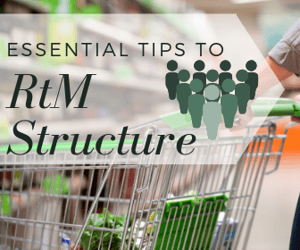When discussing Route to Market Structure, I am referring to the physical roles and people that will be needed to carry out, back up and deliver on the RtM Strategy, and goals that are proposed or have been put in place.

The types of roles that I am referring cut right through the entire sales/RtM function. From the Sales Director/VP or Head of Trade Marketing level, down through different management levels to the individual executional roles. For example, the country or end market positions in Territories (e.g. Distribution Representative), Areas/Regions (e.g. Area or Regional Sales Manager), Trade Development, Promotions, Revenue, Merchandising, Channels, Key Accounts, Horeca (Hotels, Restaurants & Cafe's/Catering), Telesales, Telemarketing, Customer Service, Modern Trade, General Trade, and so the list goes on. The point here is that my focus is the specific RtM structure and roles you will need, not the support functions (Finance, IT, HR, Supply Chain, Marketing, etc.).
When looking at RtM Structure, the starting point will always be the Strategy that we are trying to deliver on. Strategy first, then the required Structure and then the Systems necessary to support them.
Welcome to my blog series on the 20 Steps to Route to Market Excellence model. The purpose of this model and blog series is to get RtM leaders to really look at what they are doing, to ask the right questions and to look at their function in a step by step manner.
Over the past number of weeks, we have gone through the first 8 steps of the model. The focus of this post is Step 9, ‘RtM Structure’.
Here are some examples of questions you can ask under Step 9 – RtM Structure:
- Based on the RtM Review in Step 1, what is the current RtM structure and how does it perform? How does this compare to the competition’s RtM structure?
- What is the DIME Approach (Direct, Indirect, Mix & Everything in between) in your Market? What does that mean for RtM Structure?
- Based on our RtM approach, what type of roles could we need?
- Will we have a field force in the areas of distribution, trade marketing, specific channels (e.g. Convenience, Grocery, Modern Trade, etc.), sales promotions, events, Horeca, etc.?
- Will we require any brand, product, category specific RtM personnel? If so, will the personnel be exclusive to one brand, product, category? Who manages them? How does this impact on our RtM structure?
- How will we manage and service the marketplace, by regions, areas, channels, cities, etc? Will it be a combination of many of these?
- Are there any external factors that could influence our RtM Structure? Do we have specific guidance or rules to follow from our wider organisation?
- Is there a global RtM structure in our organisation? How does that effect our local RtM potential structure?
- How will you link into and capture RtM learnings form other countries/markets in our organisation?
- How does integrating the RtM or Sales function with other company departments effect any potential RtM structure?
- How will the RtM structure foster two-way teamwork and support across the RtM function and the wider organisation?
- Do we have any resource constraints, either internally in the organisation (e.g. financial) or externally in the marketplace (e.g. talent)?
- If there is a skill deficiency in the local marketplace how will we address this? Can we bring in individuals from other parts of the organisation either short terms or long term? What is our plan then to move to a more locally resourced organisation?
- What is the required field force to meet out RtM goals? What back office is necessary to support this?
- What is the required management structure to meet our RtM goals?
- What is the available field force in the indirect channels and what influence do we have on Indirect resource requirements? How will this impact on RtM Structure? How will we measure performance? How will we support training and development needs in this channel?
- To what extent have we clearly defined the responsibilities and the accountability between the different Regions, Areas, Channels, Territories, Key Accounts, etc.? Have we identified any potential areas of crossover or concern? What is the plan to address these?
- Does corporate governance or industry regulation affect our RtM structure?
- What are our rules on span of control, how many individuals can report to one manager?
- What is the overall RtM structure that will facilitate the delivery on the company RtM goals?
I hope you find this useful, and I welcome any views and comments below. Next week I will cover Step 10 ‘Data & Metrics’. Please subscribe to the blog on this page, to ensure you don’t miss the latest updates on RtM excellence in execution and the 20 Steps model. If you would like to know more about the 20 Steps click here.







